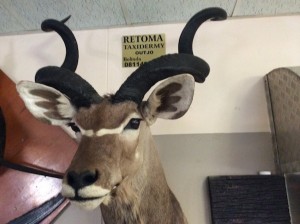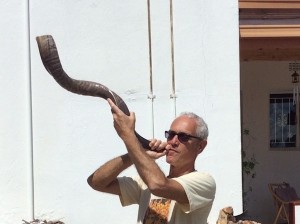On the right track to finding a place to purchase shofarot. (photo from Steven Finkleman)
Heading down the B2 from Swakopmund to Windhoek, I could see by the road signage that this would be a prime location to search for the perfect shofar. As you can see from the signage, with each kudu, one would have two shofars to blow on Rosh Hashanah.
So, I went on the prowl for the perfect shofar in Namibia. When I was in Windhoek last spring and was at the airport awaiting my return flight to the big city of Johannesburg, I happened to notice a Chassidic man on my flight carrying several long, Yemenite-style shofarot. Although I didn’t speak to him at the time, it was clear that with an abundance of African antelope, Namibia could be a good source of shofarot for Jews all over the world.
Apparently, there are two types of shofarot that are kosher to use. The original was a ram’s horn, which is linked to the biblical account of the near sacrifice of Isaac. At the last moment, a ram tangled by its horns in the bush appeared to Isaac’s father, Abraham, and he sacrificed the animal instead of his son. The other style comes from Yemen, where there was an abundance of antelope, or more specifically kudu, from which the Jews in that country were able to make shofarot.

Both styles are used today, and indeed in my own synagogue sanctuary is a painting by Gertrude Zack of a rabbi blowing a Yemenite-style shofar. Whether there are still kudu in Yemen is unclear to me. Perhaps, it is too dangerous for Jews to fly into Sanaa looking for kudu horns. Therefore, why not come to the safe locale of Namibia, known among tourists as “Africa lite” for a safe supply of kudu-horn shofars.
I was fortunate to have a work project this April in Windhoek and, clearly, one of my main goals, besides work, of course, was to track down that supply of kudu horns. It sounded like a great article: “In search of the perfect shofar, direct from its source.”
I made contact with Zvi Gorelick of the Windhoek Jewish community, and visited the synagogue, now about 80 years old, took some great pictures and attended the Friday night service. Theirs is a small community, very diverse and welcoming. Indeed, the second Shabbat, I had arranged to lead the service in my Reform style, with lots of traditional and vibrant Shabbat songs, probably quite distinct from the South African Orthodox service that the congregation was used to. Indeed, after services, I was fortunate to be invited to Barbara and Alexandra’s home for Shabbat dinner. All were welcome to join.
Once there, I was able to ask Zvi the all-important question in order for me to continue my quest for the perfect shofar. I was directed to the Nakara Tannery in the North Industrial area.
The two-dollar cab ride took me directly to the factory and the factory shop. Trying to keep things low-key and not to come across as a camera-happy tourist snapping four million pictures, I kept calm as I checked out the warehouse and then the factory store. The warehouse was filled with hides of all kinds, the most distinctive being the piles and piles of Zebra hides. Quite a sight. And, we think in Canada, it’s cool to have a bearskin on the wall!
As I entered the factory store, I noticed some kudu horns on the ground, polished, and some of very gaudy colorations – blue, orange, red, etc. Obviously not suitable for a shofar.

Trying to play it cool, I asked the sales lady at the desk, Marie-Louise, if they sell vuvuzelas made of kudu horns. Do you remember all those horns at the World Cup soccer tournament in South Africa a few years ago? She replied in the affirmative, and as I stammered away asking for a kudu-horn sort of trumpet, she responded in her Afrikaans accent, and asked if I was interested in buying a shofar for Rosh Hashanah! I knew immediately that I was at the correct spot. I coolly ordered four, but subsequently placed an order for another three. Darn good price … perhaps I ought to import them. I wonder who is making the 10 times mark-up in North America!
I then asked to see the factory where the shofarot are made. Starting with raw skulls, the horns are removed, soaked in water to remove the central core, then polished, and finally the tip is cut off in order to turn it into a shofar. I took my usual million pictures of the workshop and the production line, and, of course, tested a few shofarot out.
As I packed up my multiple shofarot, I began to wonder what sort of grief the customs officials might give me with my suitcase of kudu horns. After all, I would be crossing multiple borders, into Botswana, Zambia, Zimbabwe, the United States and, finally, home to Canada. I’d tell them the truth, of course, that these are religious article; I was unlikely to run into any trouble. Right?
Steven Finkleman, originally from Winnipeg, is a retired pediatrician living in Kelowna. He travels extensively and often researches and visits remote Diaspora communities on his adventures.

